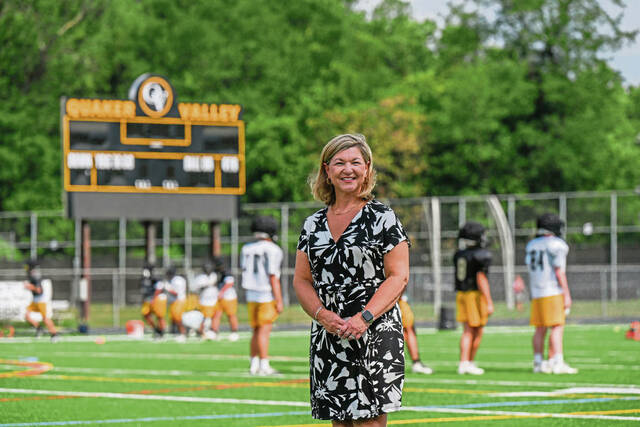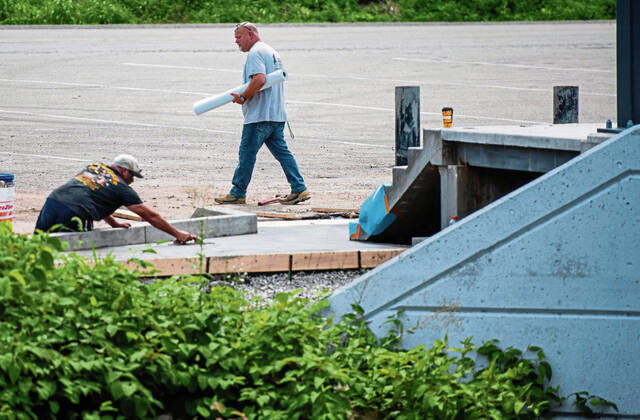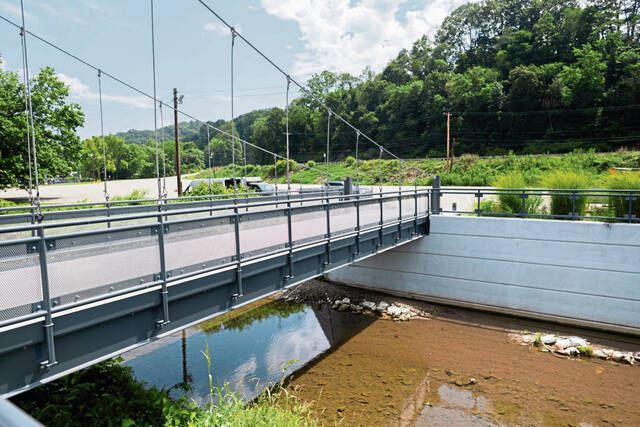Budget busters: Western Pa. schools battle rising costs, strained finances to renovate aging facilities
Superintendent Tammy Andreyko started her tenure at Quaker Valley in August 2018 meeting with district officials to discuss the possibility of building a new high school.
Seven years later, dirt has yet to be moved on the 150-acre property the district purchased in May 2017 to replace its nearly century-old high school.
New construction, large-scale renovations and regular maintenance prove challenging for Western Pennsylvania school districts facing rising costs, strained budgets and aging facilities.
Renovating to meet current building codes, updating security measures and modernizing building layouts to facilitate collaborative learning further complicate the equation.
But after more than eight years of working through property acquisition, building design and zoning approval, Quaker Valley has set its sights on breaking ground at its new high school property, Andreyko said.
The district hired in April Pittsburgh-based construction firm PJ Dick to take the lead on the $95 million to $105 million project. As the district works to finalize its permits, Andreyko is hopeful the project will go out to bid during the winter.
“They’ve been talking about it for a long time,” Andreyko said. “This is the furthest we’ve come in my tenure, and I’m just really excited for the future of Quaker Valley.”
Financial considerations
It’s no secret Pennsylvania’s 500 public schools struggle to fund their operations.
The state’s education funding system was deemed unconstitutional in 2023 through a nearly 800-page court ruling, prompting legislators to allocate nearly $526 million in 2024-25 to more equitably fund schools.
The so-called “adequacy formula” funneled the dollars through the state’s Ready to Learn block grant.
Gov. Josh Shapiro’s proposed state budget released in February advocates for another $526 million allocation to continue tackling inequitable funding — which is impacting about 70% of districts statewide, according to education advocate PA Schools Work.
Shapiro has secured more than $2 billion in additional funding for public schools since taking office in January 2023 — a historic investment in the state’s education sector. His proposed 2025-26 budget includes increases to basic education and special education funding — to the tune of $75 million and $40 million, respectively.
But as students return to classrooms, the state has yet to pass its 2025-26 budget.
It’s not uncommon for Pennsylvania legislators to pass the budget after the statutory June 30 deadline. The budget has been approved on time just eight times in 21 years.
But that also means that more often than not, school board directors are left to make budgetary decisions without knowing how much state funding they will have for the upcoming academic year.
The future of federal education funding also remains up in the air. The U.S. Education Department said in March it would lay off more than 1,300 of its more than 4,000 employees and terminate leases on several of its buildings.
Though it is unclear how the changes might impact school funding, New Kensington-Arnold Superintendent Chris Sefcheck said the district has noticed a recent drop in federal dollars.
The district reached into its savings, Sefcheck said, to balance its budget — already strained by cyber charter tuition payments and growing retirement payements.
And to account for uncertain state funding, the district chose in June to direct additional local dollars to the general operating budget — reducing the amount it would normally allocate to its capital reserve.
Failing to fully fund its capital reserve could affect the district’s ability to repair and maintain its four 60- to 100-year-old buildings, Sefcheck said.
“We had to pass a budget without knowing what we’re getting from the state or the federal government, which is not even close to being resolved,” he said. “Any other things that we have in our vision are going to be on hold.”
Revised PlanCon process remains unfunded
School districts for decades relied on the state’s Planning and Construction Workbook — also known as PlanCon — to finance building or renovation projects. The system partially reimbursed schools for large building projects until 2012, when a significant backlog of projects awaiting payments led to a moratorium on new applicants.
PlanCon typically reimbursed schools for 10% to 20% of their project’s total cost, said Erin James, press secretary for the state Education Department. The exact percentage was based on the interest rate of the project’s bond, as well as student enrollment and poverty levels at the district applying for reimbursement, she said.
The state estimated the backlog was more than $1 billion in the mid-2010s. PlanCon has only been funded three times since 2012 — in 2014-15, 2015-16 and 2017-18.
A revised PlanCon process established in 2019 has yet to be funded. It includes an adjustment factor to ensure longevity of the program, if it were to be funded.
“In other words, as the number of funded projects would go up, the amount of funding for each project would go down — ensuring high demand did not cause the program to exhaust its resources,” James said.
Baldwin-Whitehall’s $48 million elementary school build was one of the final projects statewide to be funded by PlanCon, Superintendent Randy Lutz said.
R.A. Lutz Elementary — named after the superintendent — opened in January 2024, replacing the former W.R. Paynter Elementary School. The displaced elementary students were shifted to the district’s J.E. Harrison Middle School, creating additional wear on the building last renovated 30 years ago.
The district is finalizing a $20 million renovation of the middle school — including plumbing and electrical repairs, new ceiling and floor installation and a reworked industrial arts space.
But without the support of PlanCon this time around, the district raised taxes 1.15 mills last school year, directing about 0.33 mills — or $627,000 — toward the middle school renovation, Lutz said.
One mill brings the district $1.9 million, he said.
“It hit local taxpayers,” he said. “Basically, we were using some local reserves as well as making sure that we were budgeting properly, and it did impact millage rates.”
In place of funding PlanCon, the state doled out $75 million in 2023-24 to help districts make environmental repairs — such as eliminating lead, mold, asbestos or other hazards. The state allocated $100 million this past year to support school facility improvements.
Plum Borough School District received a $1.9 million state grant to upgrade its middle school, said Chief Financial Officer Ryan Manzer. The project, slated for completion toward the end of the 2025-26 academic year, will replace HVAC controls, exterior doors and windows, concrete in the building’s rear courtyard and the dust collector for the school’s technology education room.
The grant will support nearly half of the project’s $4 million price tag, Manzer said. But as the district prepares to shoulder about $28 million in renovations and construction of a 7,800-square-foot addition at its O’Block Elementary School, grants alone might not be enough.
“Aside from the grants we receive that we certainly appreciate,” Manzer said, “there isn’t a very structured process for state support related to these larger building renovations.
“We really had to manage this on our own.”
Manzer doubts the state will fund the updated PlanCon process anytime soon.
“It doesn’t appear to us that— on the near term horizon — (the) PlanCon process will be reinstituted to a certain degree,” he said, “but we would certainly lobby for something like that to happen so we can really rely on consistent funding and be able to plan for these projects into the future.”
Rising costs, aging facilities
Construction costs are also on the rise, having increased by nearly 67% in the past decade, according to Tall Timber Group — a Ross-based construction and real estate consultant. The group publishes a bimonthly magazine on industry trends on behalf of the Master Builders’ Association of Western Pennsylvania.
As Greensburg Salem contends with a limited budget and aging facilities, figuring out where to start is the most difficult part of the renovation process, said Superintendent Ken Bissell.
Greensburg Salem Middle School is more than a century old. Two of the district’s elementary schools — Metzgar and Nicely — and its high school were built in the 1960s, receiving a few upgrades in the decades since then. Its Hutchinson Elementary was built in the 1990s and has never received a renovation.
The district will operate this school year on a $53 million budget.
With the help of an energy-savings company the district hired last August, Greensburg Salem is chipping away at a long-term overhaul of its facilities.
The first round of projects started this past school year — including new floors, ceilings, windows, lighting, ADA-accessible bathrooms and a secure front entrance at Hutchinson; water-efficient fixtures in the high school bathrooms; and a new roof, windows, doors and lighting at the fitness center.
The renovations will cost about $3.4 million — addressing multiple relatively small projects rather than tackling a single major project, Bissell said.
“It is a difficult task to align everything,” he said. “And we’ve said ‘How do we eat an elephant?’ It’s one bite at a time, but then the question is ‘Where’s the first bite?’ ”
Greensburg Salem determined Hutchinson Elementary and the high school would be a good place to start because of the buildings’ long-term importance to the district — particularly as district enrollment remains stagnant.
Graduating class sizes have held steady for the past five years, Bissell said, falling to between 180 and 220 students. This is a notable decrease from about 15 years ago, when classes consisted of about 280 students.
Though there are no concrete plans to eliminate any schools, the district has preliminarily discussed during facility committee meetings whether it still needs all five of its buildings, Bissell said.
The school board committee has also discussed the financial viability of renovating versus building new facilities.
“Our middle school building is over 100 years old, so any work that we do in the building, we would need to make sure we brought things up to code,” Bissell said. “That makes it more difficult.
“Not that you can’t do it, but it makes it more difficult than in a (newer) building, which could then be more costly.”
Security, education standards
Modern security and education standards also play a role in building renovation discussions, Bissell said.
The meaning of school security, in particular, has changed drastically since many of Greensburg Salem’s buildings were renovated or built in the 1990s.
“That’s a thing that’s changed since Columbine — the locations of office spaces, the doorways, having certain locking mechanisms on doors, making sure that there are areas to monitor visitors, making sure that the rest of the building is on lockdown,” Bissell said.
The superintendent referenced a 1999 school shooting incident in Columbine, Colo., in which 13 students and a teacher were killed.
“Newer construction may not have as many locations of entrance, but when we have buildings as old as ours, we have to do different things to just make sure that it’s more secure.”
The district is installing a “mousetrap entrance” at Hutchinson Elementary — requiring visitors to be screened in a secure waiting area before entering the building.
And as education shifts away from lecture-style instruction, classroom configuration and resources will likely play into future renovations, Bissell said.
“The idea of 30 desks aligned in six rows of five, that’s not what the structure should be looking like if we really want kids to be collaborators, problem-solvers, resolving conflict with one another,” he said.
This concept was a main driver behind Baldwin-Whitehall’s decision to rework the industrial arts space at its J.E. Harrison Middle School.
The space used to be a shop classroom, marked by the traditional array of heavy-duty 1950s equipment.
“We really wanted to think differently around that,” said Lutz, the superintendent. “Most of what kids do in those spaces is dependent upon the adults, because you’re dealing with table saws and band saws and other types of heavy-duty equipment.
“It’s not very forgiving, and a simple mistake on something like that, a child might be losing fingers or worse. We really wanted to make an area that was conducive to student involvement and engagement.”
Ahead of this school year, the walls of the shop classroom were knocked down, creating one open space for the building’s shop, maker space and family and consumer sciences students.
“The idea there is to have some interdisciplinary type projects that could be multimodal,” he said. “We’re really looking at how the teachers can work together in that space.”
Quincey Reese is a TribLive reporter covering the Greensburg and Hempfield areas. She also does reporting for the Penn-Trafford Star. A Penn Township native, she joined the Trib in 2023 after working as a Jim Borden Scholarship intern at the company for two summers. She can be reached at qreese@triblive.com.
Remove the ads from your TribLIVE reading experience but still support the journalists who create the content with TribLIVE Ad-Free.



